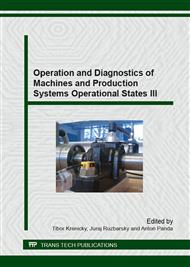[1]
Š. Gašpar, J. Paško, Analysis of influence of pressing speed, of melt temperature and of casting position in a mold upon ultimate tensile strength Rm of die casting from aluminium, Advanced Materials Research 909 (2014) 3-7.
DOI: 10.4028/www.scientific.net/amr.909.3
Google Scholar
[2]
Š. Gašpar, J. Paško, J. Majerník, Crystallization of aluminium alloys, Applied Mechanics and Materials 624 (2014) 48-51.
DOI: 10.4028/www.scientific.net/amm.624.48
Google Scholar
[3]
J. Paško, Š. Gašpar, Eutecticum morphology in Al-Si alloys, Advanced Materials Research 1014 (2014) 9-12.
Google Scholar
[4]
J. Paško, Š. Gašpar, J. Ružbarský, Die casting defects of castings from silumin, Applied Mechanics and Materials 510 (2014) 91-96.
DOI: 10.4028/www.scientific.net/amm.510.91
Google Scholar
[5]
T. Krenický, Specifics of diagnostics and vibration damping in die casting technology (Špecifiká diagnostiky a tlmenia vibrácií v technológii tlakového liatia), in: Scientific Papers: Operation and diagnostics of machines and production systems operational states, Tribun EU, Brno, 2008, pp.119-123.
Google Scholar
[6]
E. Ragan, Contribution to the dynamism of the treatment facilities for die-casting (Príspevok k dynamike ošetrovacieho zariadenia pre liatie pod tlakom), Foundry/Slévárenství 7 (1984) 283-285 (in Slovak).
Google Scholar
[7]
E. Ragan, Die-casting Process (Proces liatia pod tlakom), FMT TUKE, Prešov, 1997 (in Slovak).
Google Scholar
[8]
J. Ružbarský, Dynamics of core taking out at die casting, Applied Mechanics and Materials 616 (2014) 244-251.
DOI: 10.4028/www.scientific.net/amm.616.244
Google Scholar
[9]
T. Krenický, P. Jacko, Real-time monitoring of technical systems operation (Real-time monitoring prevádzky technických systémov), Strojárstvo Extra 5 (2011) 32/1-32/2 (in Slovak).
Google Scholar
[10]
T. Krenický, Multi-parametric monitoring using virtual instruments, SHMD´2014: 11th International Symposium of Croatian Metallurgical Society: Summaries of abstract; Šibenik, Croatia, June 22-26, 2014, Zagreb, Croatian Metallurgical Society, Metalurgija 53/3 (2014).
Google Scholar
[11]
E.J. Vinarcik, High Integrity Die Casting Processes, John Wiley and Sons, New York (2003).
Google Scholar
[12]
J. Žitňanský, J. Žarnovský, J. Ružbarský, Analysis of physical effects in cutting machining Advanced Materials Research 801 (2013) 51-59.
DOI: 10.4028/www.scientific.net/amr.801.51
Google Scholar
[13]
T. Duraník, J. Ružbarský, M. Stopper, Influence on the Productivity of Modern Thermoset Preheating in the Compression Molding Technology, Advanced Materials Research 717 (2013) 74-78.
DOI: 10.4028/www.scientific.net/amr.717.74
Google Scholar


